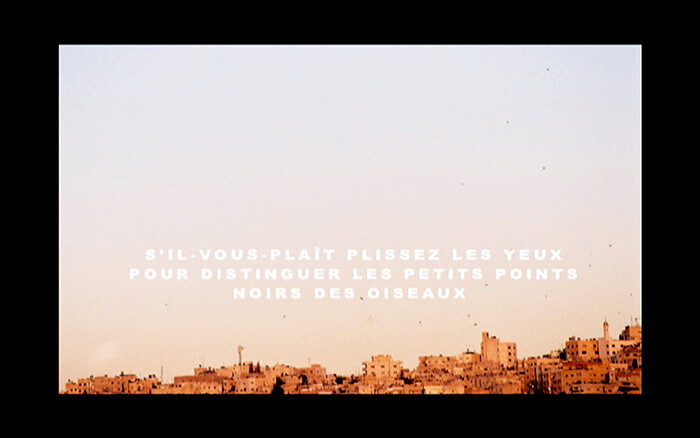“A video titled Milk and Honey.” These are the opening subtitles appearing on a plasma screen in the first room of Basma Alsharif’s solo exhibition in Paris. The following words, spoken in Arabic by a male narrator, introduce a story to come, of a woman’s lost love. They immediately remind me of Song of Songs (or Song of Solomon), a love story from the Old Testament often interpreted as an allegory of the relationship between a people and a nation: “Your lips, my bride, drip like the honeycomb. Honey and milk are under your tongue. The smell of your garments is like the smell of Lebanon.”1 Then, the narrative shifts to the making of the video and the admission of its failure: “What I was left with was a video with no images.” At this point, we are able to identify Alsharif’s own subjectivity behind the man’s voice. She describes all the material she collected while she was in Beirut, as well as her initial intention to create a “fictional love story set in the Middle East devoid of political context.”
The video is surrounded by an extensive display of photographs that are all part of an installation titled The Story of Milk and Honey (2011). Much like the rest of the works on view at Galerie Imane Farès, this installation testifies to Alsharif’s inability to speak about a place inaccessible to her. Born in Kuwait to Palestinian parents, she grew up between the United States and France and now leads a nomadic life, traveling internationally with an American passport. In the introductory exhibition handout written by Israeli filmmaker Eyal Sivan, one finds a quote from Alsharif in which she expresses her distress of not being able to re-enter her ancestral homeland, the “PROMISED LAND,” as she puts it. Alsharif originally wanted to write a love story about the Levant, as if it were a classical Arabic song, but ultimately she found herself conflicted by questions of nationalism and its underlying orientalist rhetoric.
Experimenting cinematically with autofiction—a literary genre of fictionalized autobiography—seems to have opened up a critical space for her, imbuing the narratives with a sense of nomadism. Due to her own personal connection to the political and cultural history of the Middle East, Alsharif realized that her attempt to write a purely fictional love story was unachievable. However, she did manage to produce three series of images, which are also described in the video “Original Family Archives” (2011), a series of family portraits and found photographs of anonymous persons with the faces erased; “Les Sauvages” (2011), a group of photographs of drawings and botanical texts in which all the words related to plants have been removed; and “Corniche Beirut” (2011), a series of photographs she secretly took of pedestrians on a seaside boardwalk in Beirut. The juxtaposition of these images on the gallery walls contributes to the installation’s fragmentary nature, introducing an indeterminancy between imaginary and personal facts.
Alsharif unifies the exhibition by ensconcing its diverse works within a simulated natural environment. Entering the gallery space feels like entering a garden showroom: the floor is covered with an intense, emerald-colored synthetic turf topped with potted plants, which lend the show an exotic, orientalizing feel. In keeping with the concept of the doppelgänger, or “ghostly double,” its three different installation works overlap with one another, suggesting that different narratives can cohabit the same space. The “double” is also present as a self-reflexive means of traveling in time and space, like a stateless paradigm that exceeds borders. A reproduction of a vintage poster of the Olympic Games introduces the overall narrative of Girls Only (2014), an installation that includes a 16mm film projection and a series of prints altered with India ink. The poster features the elliptic symbols of the former USSR, while the others incorporate representations of athletes who embody the patriarchal notion of a “fatherland”; the words directly referring to the Olympic Games have been obscured with black bars, revealing the posters’ ideological iconography even more clearly. At the end of the corridor, the film set in Athens’s Panathenaic Stadium serves as a counterpoint to these images, featuring a girl repeatedly reciting words relating to notions of masculinity.
In the gallery’s basement, the video installation Deep Sleep (2014) activates a hypnotic state with color flickers and binaural beats. Shot on Super 8 film (and later transferred to high-definition video), Alsharif experiments with the idea of being in two places at the same time while hypnotizing herself amid ruins in Athens, Malta, and Gaza. Her approach recalls French scholar Raymond Bellour’s examination of hypnosis in cinema, which advances the medium’s dispositif as the viewer’s doppelgänger—as a physical body with gaze, presence, shadows, mass, and skin.2 Similarly, the performative dimension of Alsharif’s work emphasizes the corporeal qualities of cinema, with the texture of the film and the movements of the camera underpinning the idea of a body double. Even the artist’s own doppelgänger appears on screen. Intermittently, we see her walking around with a microphone while recording the film’s audio track—an act which stages both her cinematic double and the process of rendering it with sound simultaneously. Just as Deep Sleep demonstrates how doubling might possibly become a healing device of exile, Alsharif’s viewer experiences the uncanny, overlapping duplication of space, body, and memory in her exhibition-qua-autofictional garden, like a nomadic wanderer.
Sg 4:11 (New International Version).
Raymond Bellour, Le corps du cinéma: Hypnoses, émotions, animalités (Paris: P.O.L., 2009).









